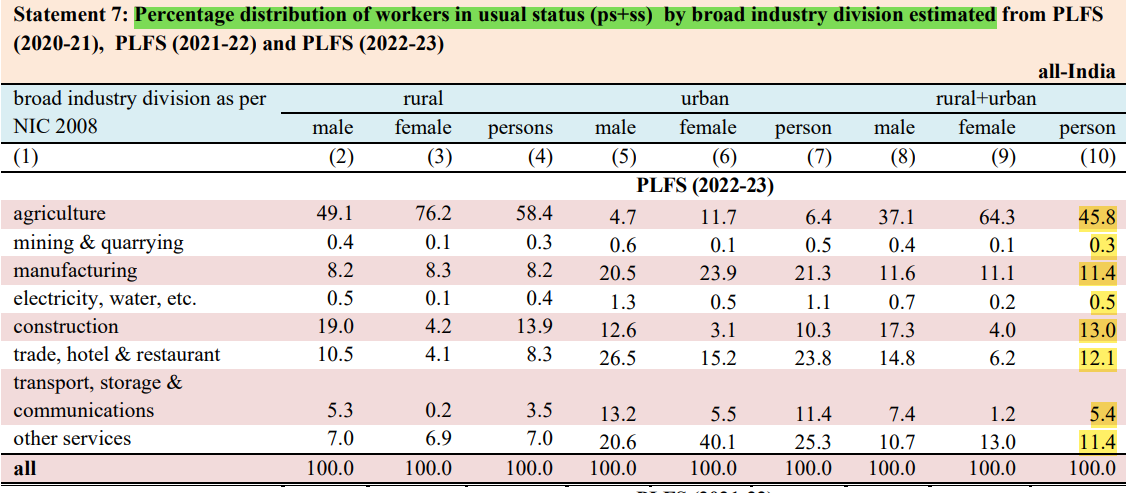Periodic Labour Force Survey Annual Report
About PLFS
-
- In India, the National Statistical Office (NSO) has been quinquennially (over a period of five years) collecting data on employment and unemployment but from 2017 onwards, the Periodic Labour Force Survey (PLFS) was launched by the NSO to provide quarterly employment and unemployment data.
- The NSO is a wing of the Ministry of Statistics and Programme Implementation.
- Under the PLFS, households are selected in both rural and urban areas by providing 75 per cent weightage to households where at least one member has secondary education (Class 10) or above.
- PLFS is India’s first computer-based survey which gives estimates of Key employment and unemployment indicators such as:
- Labour Force Participation Rate (LFPR): LFPR is defined as the percentage of persons in the labour force (i.e. working or seeking or available for work) in the population.
- Worker Population Ratio (WPR): WPR is defined as the percentage of employed persons in the population.
- Unemployment Rate (UR): UR is defined as the percentage of persons unemployed among the persons in the labour force.
- Activity Status-Usual Status: The activity status of a person is determined on the basis of the activities pursued by the person during the specified reference period. When the activity status is determined on the basis of the reference period of the last 365 days preceding the date of survey, it is known as the usual activity status of the person.
- Activity Status-Current Weekly Status (CWS): The activity status determined on the basis of a reference period of last 7 days preceding the date of survey is known as the current weekly status of the person.
- The PLFS also gives the distribution of educated and unemployed people, which in turn can be used as a basis for skilling of youth to make them more employable by industry.
- It also provides data on the earnings of different segments of workers.
Objective of PLFS
- The objective of PLFS is primarily twofold:
- to estimate the key employment and unemployment indicators in the short time interval of three months for the urban areas only in the Current Weekly Status.
- to estimate employment and unemployment indicators in both Usual status and CWS in both rural and urban areas annually.
Why in News?
- The National Statistical Office has released its Periodic Labour Force Survey Annual Report 2022-2023.
Highlights of the Report
- India’s Unemployment Rate (UR) for persons aged 15 years and above at the all-India level came down to six-year low of 3.2 per cent in 2022-23 from 4.1 per cent in 2021-22.
- In rural areas, UR decreased from 5.3 per cent in 2017-18 to 2.4 per cent in 2022-23 while for urban areas it decreased from 7.7 per cent to 5.4 per cent. The UR for male in India decreased from 6.1 per cent in 2017-18 to 3.3 per cent in 2022-23 and corresponding decrease in UR for females was from 5.6 per cent to 2.9 per cent.
- The survey also showed that the Labour Force Participation Rate (LFPR) in usual status for persons of age 15 years and above increased to 58 per cent from 50 per cent in 2017-18.
- LFPR: Rural areas – 61 per cent, urban areas – 50 per cent, male – 79 per cent, female – 37 per cent.
- The Worker Population Ratio (WPR) in usual status for persons of age 15 years and above also increased to 56 per cent in 2022-23 from 47 per cent in 2017-18.
- WPR: Rural areas – 59 per cent, urban areas – 48 percent, male – 76 per cent, female – 35 per cent.
- While about 80 per cent of those working in rural India are self-employed or casual workers, the proportion is over half even in urban India.



- In rural India, 58.4 per cent of the jobs are in agriculture, while construction, manufacturing, trade and restaurants account for 13.9 per cent, 8.2 per cent and 8.3 per cent, respectively. In urban India, trade and hotels, at 23.8 per cent, is the largest employer, followed by manufacturing and construction.
- The PLFS points to the need to upgrade skills across rural and urban India to cater to India’s growth ambitions.
Subscribe
Login
0 Comments
